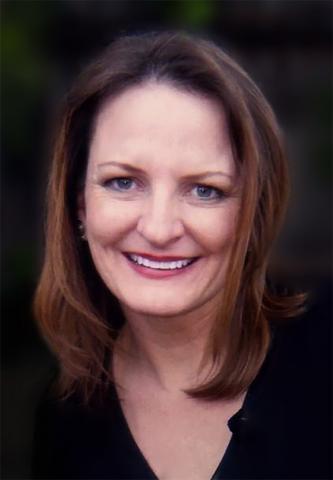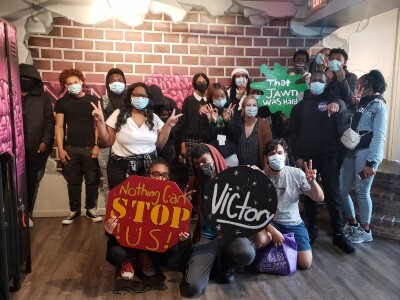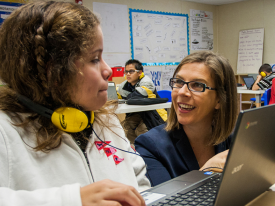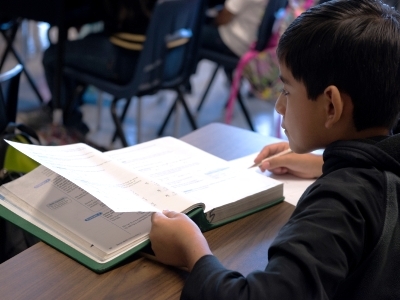Is Personalized Learning the Gateway for ALL K-12 Students to Attain Agency & Achievement?
Topics

Together, educators are doing the reimagining and reinvention work necessary to make true educational equity possible. Student-centered learning advances equity when it values social and emotional growth alongside academic achievement, takes a cultural lens on strengths and competencies, and equips students with the power and skills to address injustice in their schools and communities.
Examining whether this new approach could hold significant promise for a variety of student populations, including special needs, ELL, and gifted students.
My recent tour of several NGLC Breakthrough Models schools was an eye opener, a paradigm- shifter and ultimately, shook up a few limiting beliefs I had gained during my experience teaching in traditional educational settings.
As a newly-hired teacher at The Incubator School, an innovative school in its second year, I was excited to participate in a recent NGLC tour. The experience has deepened my understanding of our own blended learning, design model. I now know that large-scale, radical innovation is not only possible, but also probable as word spreads about the phenomenal work being done by educational innovators! True social justice can be achieved through education, where learning is personalized and students develop the agency to unleash their inherent potential to create, innovate and become productive, dynamic citizens of the world.
My optimism for public education has been reinvigorated by observing firsthand the engagement, autonomy and agency of students from a range of grade levels and socioeconomic backgrounds at schools in various stages of development. My personal perspective is informed by a corporate business career followed by 11 years of teaching, as well as my own experience as a parent struggling with traditional school systems that were often unwilling or unable to identify, nurture and support my own child’s gifts.
Since childhood, I have been passionate about working with “at-risk populations” and often volunteered with nonprofits. My experience spans every grade level K-12, every socioeconomic level, in a variety of settings including hospital schools, comprehensive elementary and high schools, a 6-12 leadership magnet, first-year pilot high schools, and a restructured high school where significant gains were made in standardardized test scores and in introducing a “college-going culture.”
When I was finally able to enter the teaching profession, I was astonished at the indifference others exhibited toward the blatant dissonance between crucial real world skills and those taught in the world of education. My efforts at making such real world connections for students through community partnerships were successful--however, they were often stymied by the various forces of inertia common in traditional education settings.
I felt disempowered to implement innovative ideas on a large scale due to the inevitable undermining by those attached this culture--a culture that attributed any lack of student and school success to external factors. Like so many other educators carrying battle scars from implementing unwelcome change in public education, I wished I’d chosen some other pathway to work with struggling kids; a pathway that would have allowed me to effect real change in the lives of individual students by facilitating development of their inherent potential, while preparing them for the rigors of the real world.
Fortunately, the disconnect between the real world and the world of traditional education is aggressively being addressed with new personalized learning models. In my years of teaching, the degree of student engagement and autonomy I observed on a recent NGLC tour of personalized learning environments in the Bay Area was unprecedented. Personalized learning models address the disconnect between the need for real world skills and knowledge and traditional school curriculum by giving students varying degrees of choice in their own learning process. Social and emotional learning programs are designed to teach kids skills and traits such as teamwork, decision making, project management, grit, and self-regulation needed to access the 21st century economy and live an empowered life. Below are some reflections on from this awe-inspiring tour.
Summit Denali
Here, two groups of about 50 6th graders had gathered in a large open floor arrangement managed their own learning process with three students independently reconfiguring furniture arrangement for transition to group work.

Students were fully engaged in various tasks and able to independently navigate playlists, focus areas, goal screens and work product screens on computers. Students working at their own pace on teacher-designed projects made choices about their learning. After scanning the room, I finally located the teacher assisting a student. What is happening here to result in such high levels of student ownership in their learning, and in engagement? When I asked about challenges with students with IEPS and ELLs, I was told that figuratively speaking every student has an IEP because every student has an individualized learning path, with resources for whatever he or she needs to access playlists and facilitate mastery.
Alpha Middle School
When asked how this school—with a significant poverty benchmark of 95% free and reduced lunch—compares to others, its students enthusiastically explain how the peer mediation program prevents bullying and how teachers have weekly open office hours dedicated to students only. Another explained, “Students help each other meet their goals at this school. The school is like our second family.”

Students have an awareness of each other’s NWEA Map Goals and often support each other in meeting them. Principal John Glover emphasizes that students should be so engaged in learning that nothing else matters to them in that moment. Physical education and advisory are combined for integration of physical and SEL goal coaching and progress monitoring. Each student has an Individual Learning Plan with smart goals which is monitored in the PLT (Personalized Leadership Training). Growth mindset is taught and reinforced through step by step tracking of PE skills which are explicitly generalized to build students’ agency.
Weller Elementary
In this uplifting and dynamic school environment in Milpitas Unified School District, elementary students in both the learning lab and regular classes are seated comfortably around the lab and engaged with online learning. Teachers met with individual students to review goals and progress while instructional assistants monitor those working on online reading and math games.

In one of the regular classes, the teacher instructed primary students on building a web page. Students continued to engage with online content despite the distraction of our tour group. I did not observe any redirection of students in any of the classes or the lab at Weller.

Design Tech High
At this first year school with 9th graders only, students demonstrate self-directed learning while teachers act as facilitators of learning. IEP’s become less meaningful since every student is working at their own pace and every student is given support and scaffolding necessary to succeed. The curriculum is focused on noncognitive transferable skills in a Design Model so that students will be prepared to thrive in the 21st century economy.
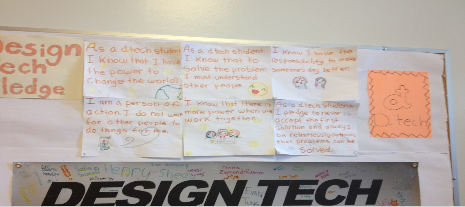
Extreme personalization using Design Thinking Principles are the driver for the curriculum with Stanford’s IDEO involvement and guidance. The school is working toward a model where students will create their own learning schedules weekly using a dropdown menu of available supports, driven by competency-based goals and students’ immediate learning needs. Now, students’ schedules are created in collaborative staff meetings each week, where they are based on pace and performance and depending on the student’s needs.
MOOC instruction took place in a classroom setting where teachers facilitated completion. Some students were preparing for an appointment to present a speech online with a Brigham Young University professor. The teacher was available to help as needed. Other students were working with a photography professor on a project that included interacting with the public. Staff shared their excitement about a new community partnership with Oracle’s food catering program at the Oracle Arena (formerly known as Oakland Coliseum Arena) where students will learn all facets of a large catering operation.

At Design High, students speak enthusiastically about their experience and wish more high school students could have this type of learning experience.
Epic School
At this STEAM school with 99% free and reduced population, we encountered students working with CAD software in a design class. Many used tools and materials in the maker lab while others worked independently on basic academic skills in a blended program.

All of this is happening in the context of immersion in a rich theme based on Joseph Campbell’s “Hero’s Journey.” In this model, students follow the heroic journey of mythical person Richard Parker while simultaneously engaging in their own journey. Joseph Campbell’s Hero’s Journey phases have been translated into kid-friendly graphics that outline the steps and challenges of moving through the call to adventure. A cartoon image of each staff member with a biography of his or her own journey is available in the Student Handbook. Using the hero’s journey as a template through which students process academic and personal challenge provides a lens of objectivity engendering choice and control. Another way students gain agency and autonomy at Epic is through the badging system, where they earn badges associated with increased levels of freedom and responsibility as they progress through the hero’s journey.
The innovative thinking at EPIC is also reflected in the fact that no grade levels exist; students work at their own pace for three years. The student body is divided into four houses, each named after a natural element. (Houses often have friendly competitions.) Epic also places students into leagues—flexible groups of students who travel from class to class. Eventually each league will have its own “sandbox” or area to create its own “classroom.”

In reflecting on my observations of all the schools, I am left wondering how I could have not known more about the deep and profound changes taking place in education. At every traditional school, stories abound about the epic and often-lonely battles that take place when a changemaker arrives on the scene trying to implement change. I myself have painful battle scars from fighting those forces and alliances inherent in traditional school settings that will resist change at any cost.
Despite the fact that my most recent school environment was a transformative one with profound changes taking place, the scale and depth of change that comes from the personalized learning model is light years ahead.
Why didn’t I do more to investigate to learn more about radical transformation? How could I have created or joined a community of like-minded educators?
Because of this, I will pose this question to readers:
Are you doing all you can do to create models of education that foster engagement, autonomy, innovative mindsets, agency and grit? Are you building networks that can do this work to and would join you in this journey?
What steps could you take now to change your trajectory?

